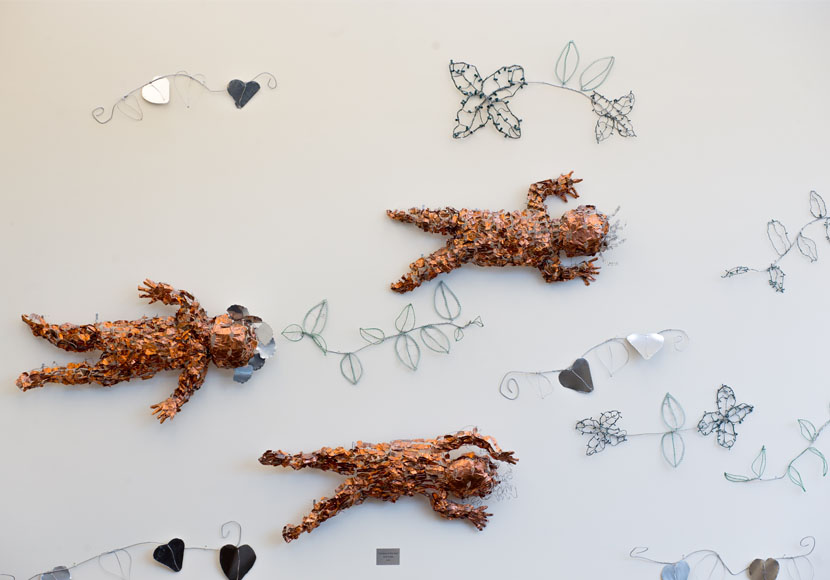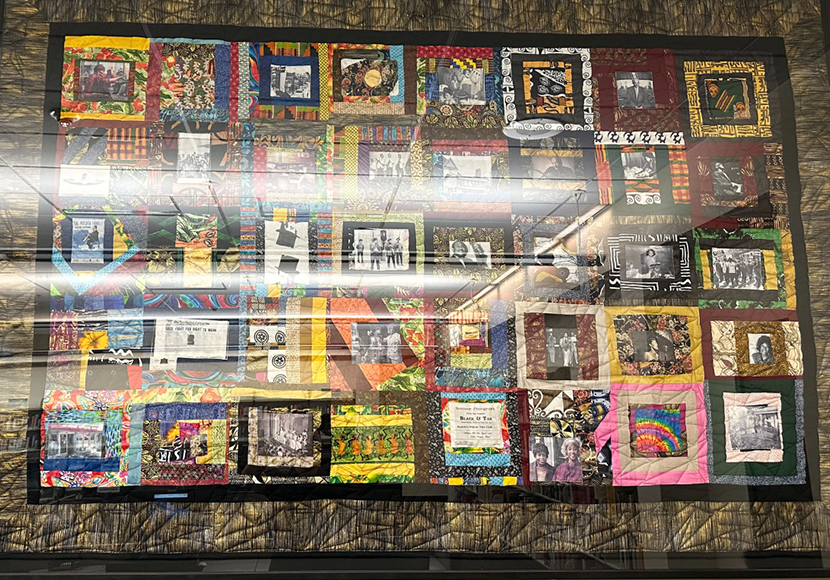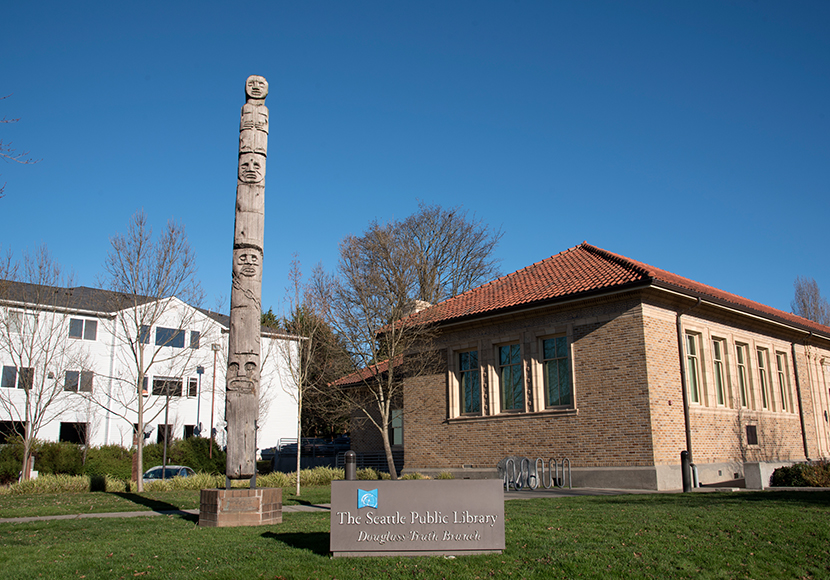Douglass-Truth Branch Art
The branch features paintings of Frederick Douglass and Sojourner Truth by Eddie Ray Walker, 3-D panels by Vivian Linder and copper sculptures by Marita Dingus, a Storyquilt by Storme Webber, and the Soul Pole, which was installed in 1973 and conserved in 2021-22.
About the Artworks at Douglass-Truth

The Douglass-Truth Branch features several distinctive art pieces that connect to the community that the branch serves.
For the expansion of the branch completed in 2006, Auburn artist Marita Dingus created copper wire sculptures of cherubs and sea grass for the branch. Artist Vivian Linder, who lives near the branch, created three-dimensional relief panels that depict her interpretation of Aztec, Mayan and Western African influences.
The branch also features two paintings of abolitionists Frederick Douglass and Sojourner Truth by artist Eddie Ray Walker, which hung in the original building and returned to the branch after the expansion.
On the lawn of the Douglass-Truth Branch, the Soul Pole, a historic wooden sculpture donated to the Library by the Rotary Boys Club, has stood tall since 1973.
Home of Good: A Black Seattle Storyquilt

A Project of Voices Rising: LGBTQ of Color Arts & Culture
- Storme Webber: Concept, Curation and Project Management.
- Lead Designer: Elizabeth Bete’ Morris
- Piecework by Pacific Northwest African American Quilters, community, & Jeanell Murphree.
The StoryQuilt was donated to Douglass-Truth Branch’s African American Collection in June 2024.
“In loving memory of Grandma Cordelia Belle, Aunt Annie and my father, Buddy.” This quilt was inspired by the closure of a treasured barbecue restaurant. The Davis family of “Home of Good Barbeque” brought their recipe from Tallulah, Louisiana to Seattle in the 1950s. My father’s family migrated here from Marshall, Texas in the 1940s. “Home of Good” was the abbreviated nickname of this beloved restaurant, and I always brought my Grandma a plate to critique, as she enjoyed every bite. This project is rooted in spaces of Black love and kindness, along with culture, fearlessness, and the struggle for justice. We remember that Dr. King came through here. We know that the restaurant forever and always looked and felt just like Grandma’s kitchen. We knew that there was comfort there. In this way, honoring this place became an entry to honoring many spaces of Black fellowship and struggle and joy. Honoring this place also became a threshold to honoring Black cultural leadership in the larger Seattle community. “Home” was also a comforting space for many marginalized people. No one was turned away, all were welcomed. For Black community history, and also for an older Seattle working class commons, for the butch Native lesbian cab driver and vet who asked for Home barbecue for her last birthday. For the hill up Yesler, for what you passed through between Yesler Terrace and Ms. Barbara’s smile. This is where my memories move and create more space for themselves. All the work that I do to remember Seattle must include the forgotten, the marginalized. So, I say this quilt also remembers those people, in the Black & Tan, or hustling far from any camera. Family, you are a part of this story. Your story is part of what keeps us warm at night. I thought of my folks, and I invited others to think of theirs, and the ones who didn’t have kin left, I tried to think of them, too. So many profound people have been left out of Seattle’s official narrative. This is a work of restoration. Because we honor these lives we lift them. We praise their courage, their perseverance, the way they shaped this world. In that way this is a medicine object. It is meant to do good work, healing restorative work, in this world." Storme Webber
Soul Pole History and Conservation
Watch a new film by Converge Media about the Soul Pole’s journey and legacy.

The Soul Pole is a 21-foot wooden sculpture depicting African-American history given to the Library in 1972 by the Rotary Boys Club. Rotary Boys Club art director Raqib Mu'ied (formerly Gregory X) led the project to design and carve a former telephone pole into the Soul Pole. Wilson Gulley, Sr., director of the Rotary Boys Club from 1968-1971, worked with Mu’ied to conceive of the Soul Pole project, and shaped many other programs for Central District youth. High school students Brenda Davis, Larry Gordon, Gregory Jackson, Cindy Jones and Gaylord Young carved the Pole, as well as other youth who attended the Rotary Boys Club.
The Soul Pole was installed on April 24, 1973, just two years before the branch was renamed the Douglass-Truth Branch in honor of abolitionists Frederick Douglass and Sojourner Truth. Over the decades, the Soul Pole became much more than a piece of public art. As Stephanie Johnson-Toliver, president of the Black Heritage Society of Washington State, has said, it represents “a beacon of pride that anchors the history of Black people to Seattle's Central District.”
As the Soul Pole weathered many seasons, its condition deteriorated. In 2021, the Library worked with Artech, an organization with extensive experience in restoration and preservation, to deinstall, repair and conserve the Soul Pole, with a focus on preserving the Soul Pole so that the community could enjoy it in its original location for decades to come. Artech worked with conservator Corine Landrieu on the plan and conservation work, which was completed in December 2021. The Soul Pole was reinstalled at its historic spot on the Douglass-Truth lawn in April 2022.
The Library has added a new plaque to display alongside the original plaque at the Soul Pole’s base to honor its conservation and history. In May of 2022, Historic Seattle announced that the Soul Pole won its 2022 “Preserving Neighborhood Character” Award.
The Library continues to work closely with the Black Heritage Society of Washington State to research the history of the Soul Pole. If you have information or stories to share, please email us.
The Library is grateful to the Black Heritage Society for their support and guidance during this project, to family members of the artists and leaders involved in the project for sharing their stories, and to Converge Media for documenting the Soul Pole’s journey in its film, “The Legacy of the Soul Pole.”
For more information on the Soul Pole project:
- Shelf Talk blog, “Soul Pole Story, A Conversation With Stephanie Johnson-Toliver of the Black Heritage Society,” Feb. 2022
- Shelf Talk blog, “Soul Pole Stories: Restoration and Conservation,” Feb. 2022

